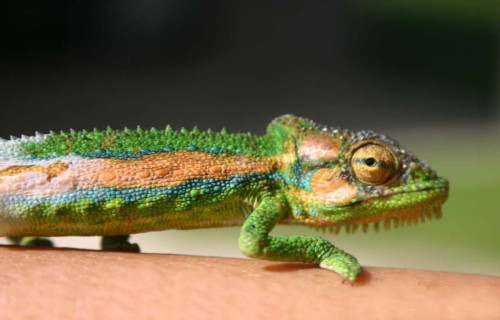
CCL: http://bit.ly/2QZT99x
We sincerely hope that you greatly enjoy reading and learning from this article about 4 Astounding African Reptiles. To be certain, this part of the world remains well known for the incredible diversity of its wildlife. This principle extends to reptiles, as well.
Quite obviously, these 4 Astounding African Reptiles represent only the tiniest handful of the hundreds of reptilian species found in the region. But we hope that these select few will serve to awaken in you an unquenchable thirst to know more.
Golden Armadillo Lizard
Golden Armadillo Lizard Facts
- Leading off this article about 4 Astounding African Reptiles is the magnificent species known as the Golden Armadillo Lizard.
- As one can easily see, the truly remarkable creature represents an incredible species of reptile. Not at all surprisingly, this remarkable lizard evolved as endemic solely to certain desert regions in one specific portion of the globe.
- The reptile also remains a unique species of animal. That holds true partly due to its rather fascinating defense mechanism. This approach to defense constitutes rolling into a tight ball, which makes it appear larger to would-be predators.
- This surprising action, which some insects share, also presents would-be attackers with its thick, armored exterior. As a result of this defensive strategy, very few predators invest the time and effort to penetrate this defense.
- The IUCN previously listed the Golden Armadillo Lizard as Vulnerable, on its Red List. Thankfully, however, the organization recently downgraded that status to Least Concern. This action occurred due to a virtual cessation in the pet trade.
Golden Armadillo Lizard Physical Description
Perhaps most notably, the extremely fascinating Golden Armadillo Lizard remains a moderately sized reptile. Yet that fact does not diminish its truly fascinating nature. What the impressive creature lacks in size it more than makes up for in other ways.
In appearance, the marvel of Nature displays visually striking patterns. That’s because its colors range from a light brown to a dark brown on top. The underbelly of the Golden Armadillo Lizard, however, appears yellow, with a black pattern.
Individual specimens, meanwhile, range in size from 6.5-8.5 in (16-21 cm) in length, with no discernible sexual dimorphism being displayed. Its bite further measures so powerful for a creature of its size that it can literally break its own jaws when it bites.
- Kingdom: Animalia
- Phylum: Chordata
- Class: Reptilia
- Order: Squamata
- Family: Cordlidae
- Genus: Ouroboros
- Species: O. cataphractus
Golden Armadillo Lizard Distribution, Habitat, and Ecology
The amazing Golden Armadillo Lizard also evolved as endemic to a highly specific portion of southern Africa. Even more specifically, though, the magnificent animal only thrives in portions of the Northern and the Western Cape provinces of South Africa.
The Golden Armadillo Lizard apparently prefers scrub brush and rocky areas for its habitat, as a general principle. Despite the great heat of this habitat, it nonetheless remains a diurnal creature, being active during the day and sleeping at night.
Quite remarkably, unlike most lizards, the fascinating reptile also typically lives in social groups. Even more amazingly, these groupings sometimes number as many as 60 individuals. More commonly, though, these groups number around 30 individuals.
Although technically omnivorous, its diet typically consists primarily of small invertebrates such as insects and spiders. Yet termites do appear to be its favorite prey. It nevertheless occasionally supplements this with various plant species sharing its range.
The Golden Armadillo Lizard also has an average lifespan measuring approximately 10 years. Individuals also typically make their home in cracks in boulders, or crevices. Finally, it represents one of the few lizards that gives birth to live young.
Spiny Bush Viper
Spiny Bush Viper Facts
- Appearing next among these choices for inclusion in this listing of 4 Astounding African Reptiles is the awesome Spiny Bush Viper.
- The small but deadly variety of reptile has managed to surprise herpetologists. That holds true due to recent discoveries about its nature. This species of snake has proven to be far more toxic than researchers previously thought.
- Thankfully, the wonder of evolution generally inhabits regions far from humans. As a result, this animal has not been well studied, with concerted efforts only now occurring. It further appears to be rather reclusive even within its endemic habitat.
- While the heavily keeled scales remain a consistent trait for the species, colors vary greatly between individuals. Hence, many people mistake individuals for members of entirely different species. Fortunately, encounters with the snake are rare.
- Within its native environment, however, the amazing Spiny Bush Viper displays some truly impressive hunting abilities. In point of fact, the fabulous, and dangerous, reptile hunts as an ambush predator, and does so most effectively.
Spiny Bush Viper Physical Description
In addition to a small size, the Spiny Bush Viper also displays a comparatively moderate degree of the characteristic of sexual dimorphism. Males attain an average length of approximately 29 in (73 cm), while females only average 23 in (58 cm).
The males of this species, meanwhile, also have a much more slender shape than the females. Additionally, the head of the males also has a short snout, much more so in males than females. The Spiny Bush Viper also has relatively large eyes.
In addition to its other unique traits, the coloring varies significantly between individuals. This nevertheless typically includes shades of blue, green, and brown. This often leads people to mistake individual snakes for members of differing species.
Yet the highly distinctive scales remain the most noteworthy, and recognizable, feature of this reptile. These distinctive features develop as heavily keeled in design. These also develop quite elongated, giving the species a shaggy or bristly appearance.
- Kingdom: Animalia
- Phylum: Chordata
- Class: Reptilia
- Order: Squamata
- Family: Viperidae
- Genus: Atheris
- Species: A. hispida
Spiny Bush Viper Distribution, Habitat, and Ecology
The deadly but beautiful Spiny Bush Viper remains endemic to specific portions of Central Africa. This includes portions of Uganda, Kenya, and Congo. The species typically inhabits regions of rainforest, since these contain large numbers of flowering bushes.
Most of these regions remain far from human habitation, making encounters rare. Further adding to this tendency is its natural pattern of behavior. These patterns remain primarily nocturnal, and its hunting and feeding habits reflect this.
This snake hunts as an ambush predator and likes to perch on reeds and small bushes. The Spiny Bush Viper also uses its prehensile tail to hang from tree limbs, waiting for prey. This mainly consists of birds, rodents, lizards, and frogs, most of which are active at night.
Females of this incredible snake generally give birth between the months of March and April. They also often have up to 12 young at a time. Scientists still know little about its venom, except that it appears to be neurotoxic, and far deadlier than once believed.
Quite interestingly, the toxicity of the venom seems to vary. As far as scientists can discover, this appears to happen in correspondence with many factors. These even include weather conditions and the altitude at which the individual snake lives.
Knysna Dwarf Chameleon

CCL: http://bit.ly/2QZT99x
Knysna Dwarf Chameleon Facts
- The third creature in this compendium of 4 Astounding African Reptiles, the Knysna Dwarf Chameleon, appears in that position only due to random selection.
- Perhaps most notably, the remarkable form of chameleon remains one of the smallest known chameleon species. Many also consider it to be one of the most colorful of all its related species. Admittedly, however, all its relatives rank as distant.
- The marvel of Nature also stands apart from other lizards for another reason. That’s because the diminutive lizard appears to be an entirely separate basal offshoot of the common ancestors of all members of the Bradypodion genus.
- Fortunately, for the moment, its numbers also appear to be relatively stable within its habitat range. That area remains, sadly, also highly restricted, however. Due to that fact, this animal currently lists as Endangered, with the IUCN.
- Finally, it does face certain ongoing threats to its existence as a species. Not surprisingly, the greatest threats to its continued existence appear to be climate change and habitat loss, much like many other creatures.
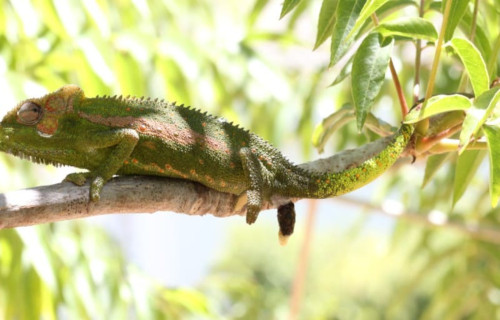
CCL: http://bit.ly/2IjEG4n
Knysna Dwarf Chameleon Physical Description
Not surprisingly, as the common name implies, the Knysna Dwarf Chameleon constitutes a relatively tiny species. That remains true due to the simple fact that its overall length only averages about 5 in (12.5 cm), including the tail.
Yet another physical characteristic also distinguishes this particular reptile from related species. That’s true since, relative to body length, it has the longest tail of any member of its genus. Its remarkable tongue can also extend twice the length of its body.
The species displays sexual dimorphism in the form of color variations between the genders. Firstly, the females typically appear either gray or brown in color. Secondly, the males generally present a bright green with streaks of pink, red, or yellow.
Like all chameleons, the Knysna Dwarf Chameleon also possesses the rather amazing ability to change its colors at will. But, it does remain unlike other lizards in one more manner. Unlike others of its kind, individuals give birth to live young, instead of laying eggs.
- Kingdom: Animalia
- Phylum: Chordata
- Class: Reptilia
- Order: Squamata
- Family: Chamaeleonidae
- Genus: Bradypodion
- Species: B. damaranum
Knysna Dwarf Chameleon Distribution, Habitat, and Ecology
Understandably, the awesome Knysna Dwarf Chameleon only lives in one specific area. That region consists of in and around the Knysna region of South Africa, on the continent of Africa. It still remains unclear whether its range ever extended further or not.
Somewhat more specifically, within that zone, it only inhabits the Afromontane forests of the region. The onset of human encroachment on its habitat, however, quickly forced it to adapt. As a result, it often adapts to living in gardens.
The species has an insectivorous diet that consists of various local invertebrates. In its native habitat, the principal predators include snakes and birds. When individuals inhabit gardens they face the threats of pesticides and human activities.
Fortunately, the impressive 42 acre (17 hectares) Steenbok Nature Reserve lies within the endemic territory of the Knysna Dwarf Chameleon. Thankfully for the small marvel, this currently provides the creature with at least a small measure of protection.
Boomslang
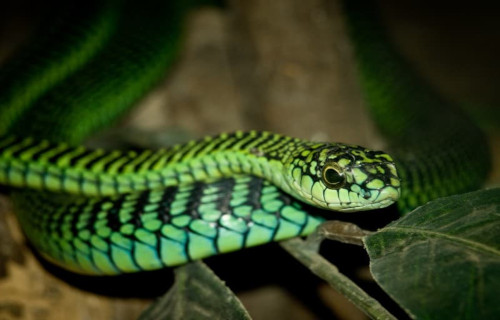
CCL: http://bit.ly/2xQPH8
Boomslang Facts
- The fourth and final entry into this compilation of 4 Astounding African Reptiles is the beautiful but deadly Boomslang.
- The somewhat distinctive term presently serves as the common name for a particularly impressive species of dangerous reptile. The remarkably impressive animal also goes by the scientific name of the Dispholidus typus, however.
- Whichever name one uses to refer to it, though, this truly amazing reptile constitutes a relatively large variety of highly venomous snake, in the family Colubridae. Currently, it also represents the only known extant member of its genus.
- In Afrikaans, the name Boomslang means tree snake. This astonishing reptile remains reclusive and shy in temperament, and would not attack unless truly under threat. It also prefers thorny bushes which make it extremely hard to catch.
- Since it is non-aggressive, the only problems arise when people, especially children, try to catch or kill it. For the moment, at least, the population numbers of the amazing Boomslang further appear to be both sufficient, and relatively stable.
- This holds true throughout the entirety of its native range. The IUCN therefore currently lists it as Least Concern. This status appears on the organization’s Red List. It must nonetheless be considered to be at some risk, due to climate change.
Boomslang Physical Description
The magnificent Boomslang also remains a highly respectable snake due to sheer physical size. And that’s in addition to its many other attributes. This holds true given the fact that mature adults of the species attain a length of as much as 6 ft (183 cm).
But, mature adults most commonly average slightly less than that. Not only that, the eyes of this particular snake develop as comparatively large. In point of fact, these develop as so large that they actually make up a good proportion of the head.
In addition to this, the fascinating Boomslang, shares a characteristic with many related creatures. It also displays a mild degree of the physiological trait of sexual dimorphism. In its case, however, this trait manifests itself in the coloring of the genders.
The male of the species typically displays a light green with black scale edges while the females usually appear light brown in color. The fangs of the incredible snake also grow longer than most arboreal snakes and are larger in the back of the mouth.
- Kingdom: Animalia
- Phylum: Chordata
- Class: Reptilia
- Order: Squamata
- Family: Colubridae
- Genus: Dispholidus
- Species: D. typus
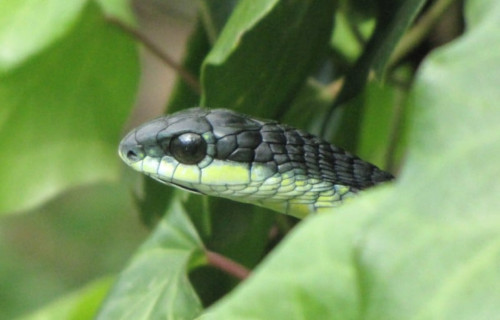
CCL: http://bit.ly/2IjEG4n
Boomslang Distribution, Habitat, and Ecology
The fascinating animal known simply as the Boomslang evolved as endemic to a moderately restricted portion of the world. But, the general area remains renowned for teeming with wildlife. It evolved as native to a certain, and surprising, area of the continent of Africa.
This highly dangerous species evolved to inhabit a particularly harsh section of the region, that of the sub-Saharan portions of the continent. In nature, though, it represents an oviparous animal, frequently producing as many as 30 eggs with each mating.
These the amazing reptile typically places in tree trunks or rotting logs. A usual incubation period is on average three months. This rather fascinating moderate-sized variety of snake primarily feeds on prey such as small mammals, reptiles, and birds.
This particular deceptively dangerous species further evolved as diurnal in nature and remains almost entirely arboreal today. The venom of the Boomslang is also extremely potent. It qualifies as a hemotoxin, creating potentially lethal internal bleeding.
It also makes the victim bleed from its gums, nose and all orifices until it dies. Respiratory arrest and cerebral hemorrhage are rather common results after a bite. The venom also acts slowly, easily up to five days, often causing victims to dangerously delay treatment.
4 Astounding African Reptiles
We truly hope that you have thoroughly enjoyed perusing this article about 4 Astounding African Reptiles. These fabulous creatures never cease to amaze those who discover them. But, this area of the globe also boasts countless other species to discover.
Sadly, though, many of these incredible products of evolution now find themselves in great peril. Worse yet, this situation seems to be deteriorating rapidly. It remains up to each of us to do all that we can to protect and preserve them for our posterity to enjoy as well.
Check out our other articles on Earth’s Many Magnificent Marsupials, Sensational Christmas Namesakes of the World, Spectacular Dolphins Throughout Our World
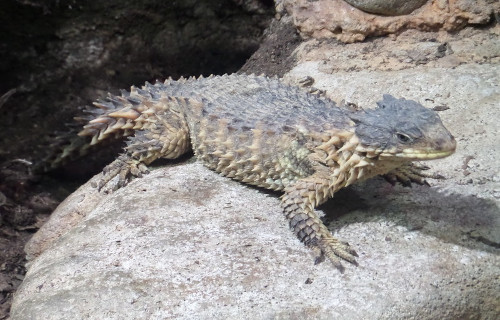
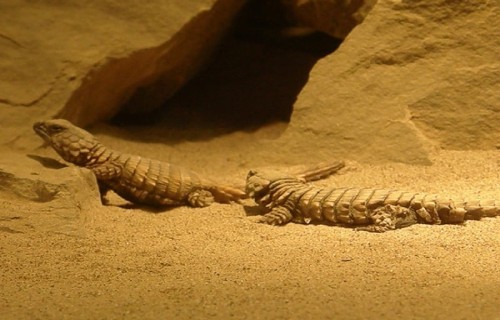
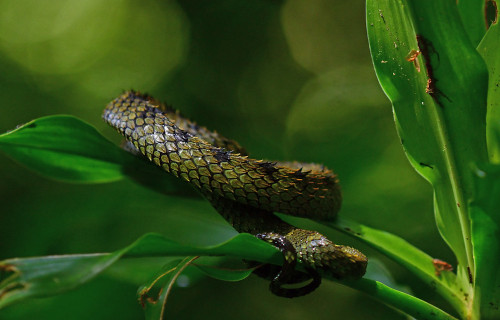
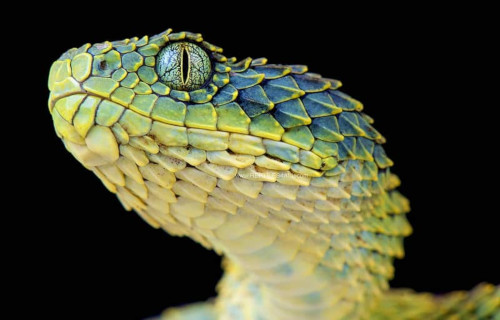
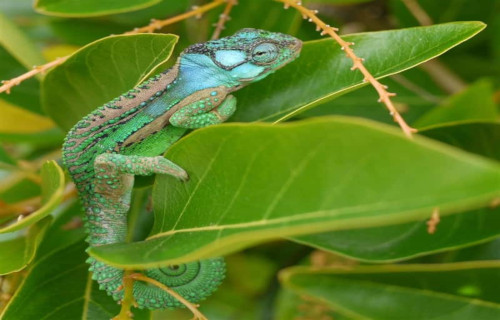
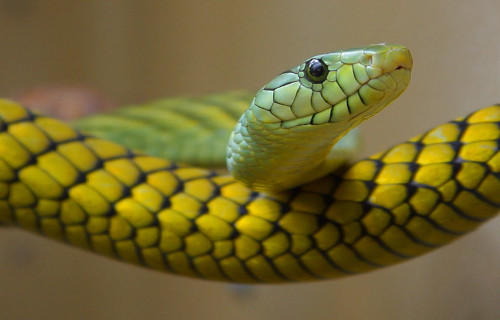









Leave a Reply